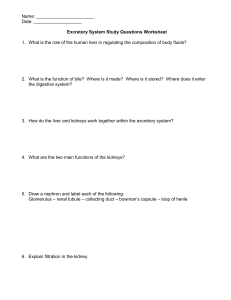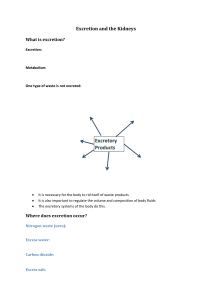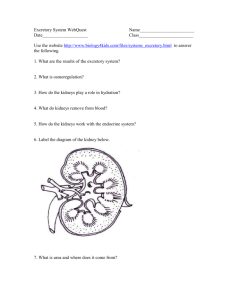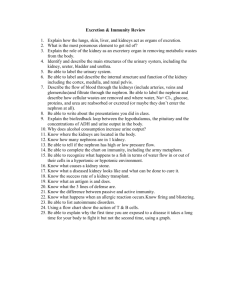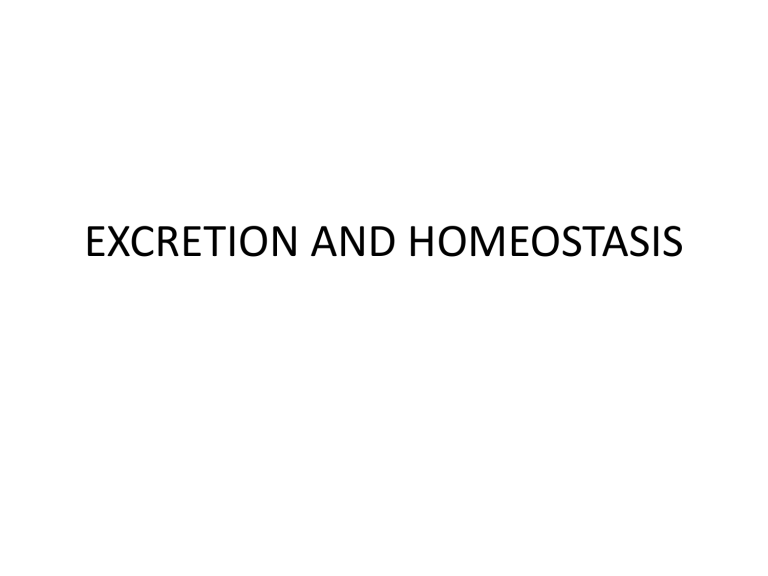
EXCRETION AND HOMEOSTASIS Excretion is the removal of waste products and harmful substances that are formed by metabolic activity from the body. Excretion These products include water, carbon dioxide, oxygen, nitrogenous compunds ( ammonia, urea and uric acid) and bile pigments. The word metabolism is used to describe the thousands of chemical reactions that take place inside of cells. Importance of Excretion Cell metabolism breaks down compounds and makes new compounds. The waste products formed during metabolism could be harmful to the body if they allowed to build up in the body, so they need to be removed by excretion. Excretion is vital so that the internal environment is kept constant so that cells in the body can function efficiently. Roles of the Excretory Organs Metabolic Waste Source of Waste How waste is excreted Carbon dioxide Aerobic respiration Removed from the blood in the alveoli and breathed out of the lungs during expiration. Mineral salts Absorbed from food when in excess Removed from the blood in sweat glands and deposited on the surfaceof the skin. Removed from the blood by the kidneys and incorporated in urine. Water Absorbed from food when in excess; produced in some metabolic reactions. Breathed out by the lungs during expiration. Removed from the blood in sweat glands and evaporated as sweat. Removed from the blood by the kidneys and incorporated in urine. The Excretory System Metabolic Waste Source of waste How waste is excreted Urea Breakdown of surplus amino acids in the liver (deamination) Small amount removed from the blood in sweat glands and deposited on the surface of the skin. Most of the urea is removed from the blood by the kidneys and incorporated in urine. Blood pigments Breakdown of haemoglobin from old red blood cells in the liver Released into the gut as prt of bile • • • The Urinary System In humans, the kidneys are the main excretory organs. There are paired organs which form part of the urinary system. The job of the kidneys is to take unwanted substances from the blood and to pass them on to the bladder, to be excreted. The kidneys have four main functions: Functions of the Kidneys They are the main organs for excretion of waste products such as urea. They play a role in regulating the water content of the body (osmoregulation). They help to maintain the osmotic pressure of body fluids by secreting excess salts and by maintain water as needed. They regulate the pH of the blood by controlling the acid-base balance in the blood. The Structure of The Kidney The kidney has three main parts – the cortex, the medulla and the pelvis. Leading from the pelvis is a tube called the ureter. The ureter carries the urine that the kidney has made to the bladder. The kidneys are made up of thousands of tiny tubules or nephrons. The Structure of the Kidney Each nephron begins in the cortex, loops down into the medulla, back into the cortex, and then down again through the medulla to the pelvis. The nephrons join up with the ureter in the pelvis. THE STRUCTURE OF A NEPHRON THE STRUCTURE OF A NEPHRON The Structure of A Nephron Filtration • Filtration is the process which separates particles of different sizes. The term ultra-filtration is used when the particles being separated are very small . Blood is brought to the Bowman’s capsule in a branch of the renal artery. Filtration in the Bowman’s Capsule Blood in the glomerulus is under high pressure. This comes about because the blood vessel (afferent arteriole) entering the glomerulus has a larger internal diameter that the blood vessel (efferent arteriole) leaving the glomerulus. This creates a build up of high pressure in the capillaries. This pressure forces small molecules from the blood into the Bowman’s capsule. Filtration in the Bowman’s capsule Small molecules, including water, amino acids, glucose, mineral salts and urea are squeezed out of the blood into the Bowman’s capsule. The mixture of small molecules and ions which forms inside the Bowman’s capsule is called the ultra filtrate. Red blood cells and large molecules such as proteins remain in the blood. The ultra-filtrate passes from the Bowman’s capsule into the proximal convoluted tubule. Selective Reasbsorption. The cells lining the proximal convoluted tubule absorb substances from the ultrafiltrate and them back into the bloodstream. As the ultrafiltrate travels through the nephron, glucose, mineral salts, amino acids and other useful substances are reabsorbed into the blood by active transport ( energy is required). The loop of Henle’ works to increase the salt content of the tissues in the medulla. The Loop Of Henle’ This helps in the reabsorption of water from the ultra-filtrate in the second coiled tubules and collecting ducts. The distal convoluted tubule and the collecting duct are also surrounded by a capillary network. Reabsorption in the Distal Convoluted Tubule Cells lining this tubule absorb mineral salts from the ultra filtrate and pass them back into the capillary. The major function of the distal convoluted tubule is to absorb water. After reabsorption, the remaining fluid continue on its way along the nephron. URINE By the time it gets to the collecting duct, it is mostly water , with urea and salts dissolved in it. It is called urine. The urine from all of the nephrons in the kidneys flows into the ureters. The ureters take it to the bladder. The urethra is a long tube which leads out of the bladder. URINATION The urethra has a sphincter muscle at the top which is usually tightly closed. When the bladder is full, the sphincter muscle opens, so that urine flows along the urethra and out of the body. How the kidneys are adapted for reabsorption Feature Explanation of how this helps absorption Tubules are long Increases surface area for reabsorption Tubules are coiled Allows tubules to be long but contained within a small space Each kidney has over a million tubules Increases surface area for reabsorption Cells lining the tubule have microvilli on their inner surface membrane Increases the surface area of each cell lining the tubule without increasing the overall size. Cells lining the tubule have many mitochondria in their cytoplasm Mitochondria produce ATP which is a source of energy for the reabsorption process. Kidney Dialysis Kidney Dialysis For our bodies to work properly the conditions surrounding the cells which make up the body must be kept as constant as possible. Homeostasis It is vital that our bodies maintain a constant internal environment, which is not influenced by external conditions. The maintenance of a constant internal environment is known as HOMEOSTASIS. The nervous and hormonal systems play an important role in maintaining this important balance in our bodies. FEEDBACK MECHANISMS Feedback mechanisms play an important role in Homeostasis. However, most of the control systems in the body are examples of negative feedback. NEGATIVE FEEDBACK When the levels of a substance in the body rise, changes are made which lower the levels again. When levels of a substance fall, changes are made so it rises again to the original levels. OSMOREGULATION The amount of water lost from the kidney is controlled by the sensitive feedback mechanism involving the Anti-Diuretic Hormone (ADH). If the water content of the blood is too low (so the salt concentration of the blood increases) special sense organs known as osmoreceptors in our brain detect this. Low water content in the Blood. They stimulate the pituitary gland in the brain to release ADH into the blood. This hormone affects the distal convoluted tubules of the kidneys, making them more permeable to water so more water is reabsorbed back into the blood. This means that less water is left in the kidney tubules so a more concentrated urine is formed. As a result, the amount of water in the blood increases and so the concentration of salts in the blood return to normal. What happens when there is high water content in the blood(dilute blood concentration)? If the water content of the blood is too high, the pituitary gland secretes much less ADH (or none at all) into the blood. The kidney then reabsorbs less water back into the blood, producing a large volume of dilute urine. Water is lost from the blood and the concentration of salts return to normal. This system of osmoregulation is an example of negative feedback. As the water concentration in the blood falls, the level of ADH produced rises. As the concentration of water in the blood rises, the level of ADH released falls. The sugar carried in the blood is glucose. Regulation of Blood Sugar The concentration of glucose in the blood is monitored closely by the pancreas and a normal concentration of 80mg per 100 cm3 The pancreas and the liver are the organs responsible for controlling blood sugar. There are a special group of cells in the pancreas known as the Islets of Langerhans. These cells secrete two hormones, insulin and glucagon. Regulation of Blood Sugar If the blood glucose concentration increases e.g after a heavy meal, the cells detect this and release more insulin and less glucagon. The insulin travels in the blood to the liver and tells it to do a number of things. The Liver under the influence of the hormone insulin: Regulation of Blood Sugar It converts glucose to glycogen and stores it It converts glucose to fat As a result the blood glucose concentration decreases. If the blood glucose decreases, the reverse happens. Control of Blood Sugar The islets of Langerhans detects a decrease in glucose concentration in the blood and secretes more glucagon and no insulin. The glucagon causes the liver to convert glycogen in to glucose. This increases the blood glucose concentration. The Control of Blood Sugar Control of CO2 The breathing centre located near the rear of the brain (medulla oblongata) regulates our breathing movements. This breathing centre (also called the master centre of the body) uses special chemoreceptors to measure CO2 concentrations in the brain and blood in the arteries. When the blood carbon dioxide concentration increases, this is detected by these special chemoreceptors in the blood vessels e.g aorta. Impulses are sent to the respiratory centre in the brain. The brain sends impulses to the intercostal muscles and diaphragm, causing their rate of contraction to increase. This causes the depth and rate of breathing to increase, which removes the carbon dioxide from the body. The skin is the largest organ in the body. The Skin It helps us to resist infection, excrete and avoid dehydration. It also has a major role to play in controlling our body temperature. The skin cntains two distinctive layers - the epidermis and the dermis: The EPIDERMIS protects the deeper layers of the skin, this is the layer that is mostly affected by sun radiation. The epidermis is split again into two layers: • The Malpighian layer produces all of the cells that make up the epidermis. These cells are constantly dividing by mitosis (a process that produces two identical cells from one original cell). The newly produced cells gradually move towards the surface of the skin. As they do this, they slowly die and fill up with keratin, a protein. These cells contain melanin which protects the tissues underneath against ultra-violet light. • The Cornified layer is made up of these dead cells. The Cornified layer protects the softer living cells underneath from damage by friction, as the dying cells become harder and are waterproof. There are various parts of the body where the skin experiences much more wear, for example the bottom of the feet. Here, the Cornified layer grows thicker and is much more durable. Melanin • This pigment absorbs the sun’s harmful ultraviolet rays. These rays can, in large enough doses, damage the genetic information (DNA) stored in the nucleus of each cell. This will in turn cause the cell to die. • Slightly smaller doses may alter the DNA which can lead to various forms of skin cancer. This can be more threatening than the cells dying. The DERMIS • The dermis is made up of connective tissue which contains elastic fibres. These fibres give the skin its stretching abilities. As a person ages, these fibres lose elasticity causing the skin to become loose and wrinkly. • It contains: • Sweat glands which secrete sweat (mostly made up of water with dissolved amounts of urea and salt), to aid in the body’s temperature control. The Dermis • Blood vessels (arteries and capillaries) which supply the oxygen crucial to the process of mitosis in the epidermis layer of the skin. They also carry blood containing heat to the skin to help in temperature regulation. • Nerve endings (receptors) are sensitive to touch, pain, pressure and temperature, keeping you aware of your surrounding environment. • Adipose (fat) layer lies beneath the epidermis. This is a layer of triglycerides. This fat helps insulate your body (slows down loss to heat gain) and acts as a reserve energy store, if needed. The Dermis • Hair and Hair erector muscles aid in temperature regulation as they raised and lowered by the muscles. • Sebaceous glands secrete sebum which prevents the skin from cracking; it helps to waterproof the skin and also inhibits the growth of bacteria. Temperature Regulation o Heat and temperature Heat is a form of energy usually measure in joules. Temperature is a measure of the degree of hotness usually measured in degrees Celsius or degree Farenheit Temperature Regulation • The body’s internal temperature needs to be kept constant as any significant variation in the body temperature could have damaging effects on the body’s enzymes. • Body enzymes work best at temperatures around 37oC. • The skin works together with receptors in the hypothalamus to control body temperature. • Any changes to the external temperature are sensed by the skin, while changes in the temperature of the body are sensed by the hypothalamus. When the Body temperature falls • When body temperature drops below the normal 37oC, the hypothalamus is activated. • This sends a message (via the nerves) to the blood vessels in the skin and they constrict (close up) to prevent heat loss. • At the same time, the hair on the skin stand uo so that they can act as insulation and trap a layer of warm air next to the skin. This is why you get goose bumps when you get cold. • If the body temperature falls further, messages are sent to the skeletal muscles and they start to contract and relax very quickly, causing you to shiver. • Shivering generates heat and your body temperature rises as a result. When the Body temperature rises • When your body temperature rises above normal , the hypothalamus sends messages to the blood vessels to make them dilate ( open wider) • This allows more blood to flow close to the surface of the skin and more heat is lost to the environment. • The hypothalamus also activates sweat glands, so you sweat more, so you lose heat through the sweat. • The evaporation of sweat also helps to lower the body temperature because it cools the body. `

